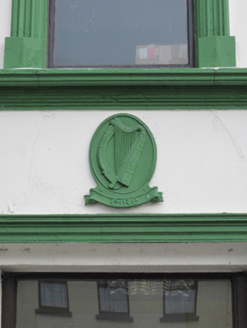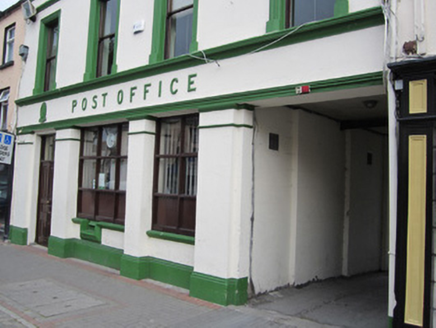Survey Data
Reg No
41308015
Rating
Regional
Categories of Special Interest
Architectural, Social
Original Use
House
Historical Use
Post office
In Use As
Office
Date
1840 - 1910
Coordinates
282662, 319771
Date Recorded
30/09/2011
Date Updated
--/--/--
Description
Terraced four-bay two-storey house, built c.1860, with integral square-headed carriageway to east end bay, two-bay two-storey extension to rear under catslide roof which incorporates two late twentieth-century rooflights, and further single-storey flat-roofed structures beyond. Converted for use as post office in 1909, with attic-level rooms lit by continuous front lucarne, to designs by John McGahon. Pitched roof with fibre-cement tiles concealed behind parapet to front, south, façade. Cement-rendered brick chimneystack with seven plain clay pots, and smaller stack on west party wall with cast-iron hopper and replacement uPVC downpipe. Painted smooth ruled-and-lined rendered walls to front façade and east gable with projecting moulded render sill and string courses, front elevation having moulded architraves to first floor openings and chamfered and stopped reveals to second floor. Roughcast rendered to rear. Square-headed window openings have one-over-one pane timber sliding sash frames with convex horns to front south elevation, while frames to rear elevation are mostly two-over-two pane. Replacement timber windows to middle bays of shopfront, square-headed doorway to west end with overlight and panelled timber door, all openings framed by moulded render pilasters. Shopfront has architrave, fascia with raised plaster lettering and metal harp motif over doorway, and moulded render cornice. Post box incorporated into moulded render sill of one display window and extends into smooth rendered stall riser with moulded render base.
Appraisal
This is a distinctly individual building with a bolder, more robust masonry appearance than many neighbouring structures of similar or earlier age as a result of its early twentieth-century alterations. Elegant lettering and simple shopfront decoration enhance its historic significance and the early addition of the official State emblem over the doorway is a very measured and dignified means of 're-branding' while respecting the original architectural composition.





